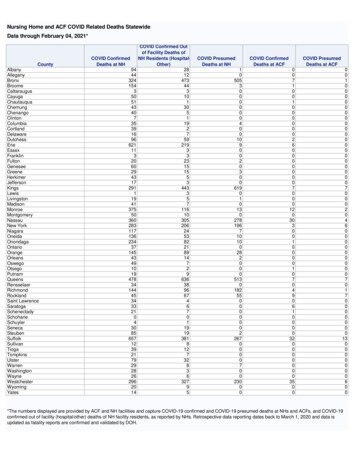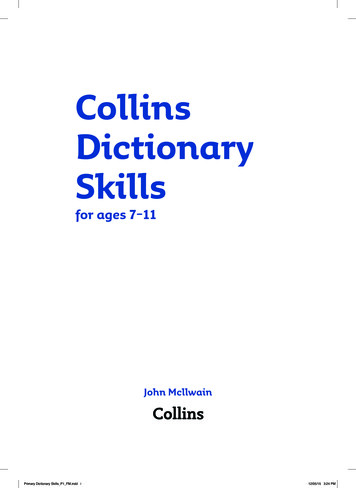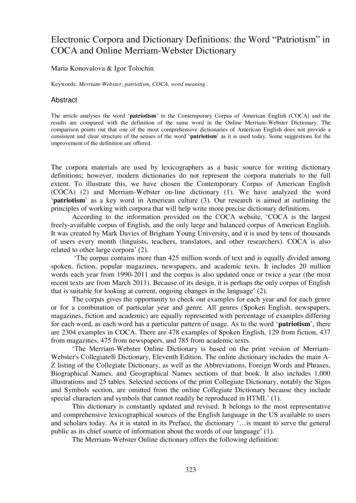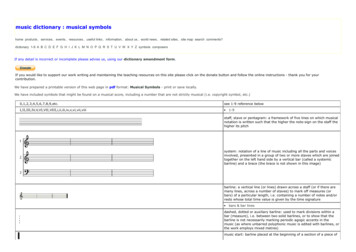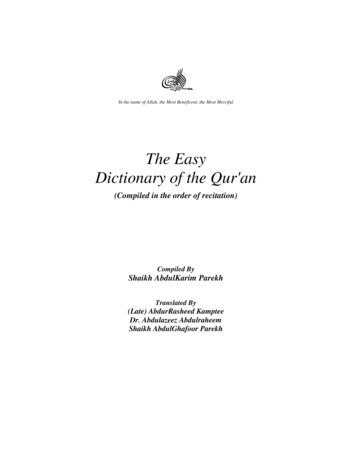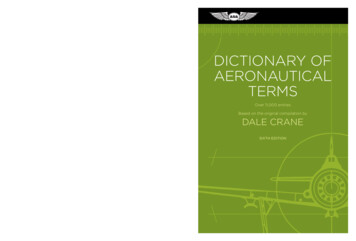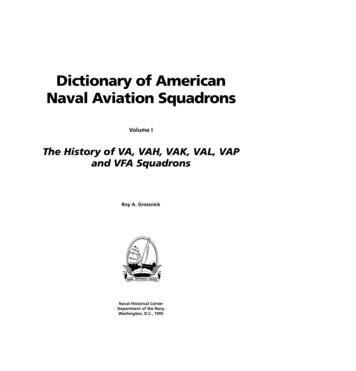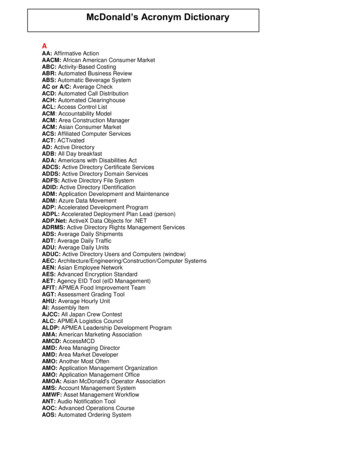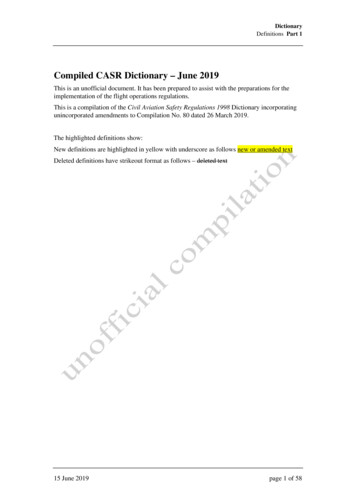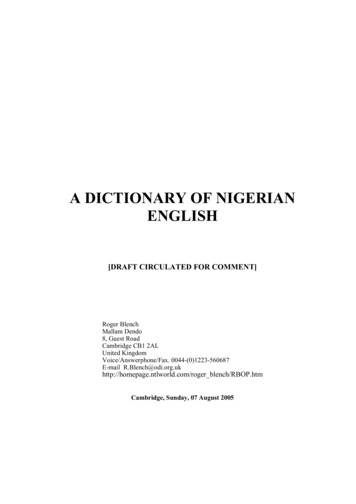
Transcription
ACADEMIC STUDIESENGLISHSupport Materials and ExercisesforDICTIONARY SKILLSFALL 1998
wDICTIONARY SKILLSACADEMIC ENGLISHACKNOWLEDGEMENTSThe following persons have contributed to the development of this learning material:Content and Structure:Curriculum Developer(s)Leslie Childs . . . . . . . . . . . . . . . . . English Curriculum Content ExpertNew Brunswick Community College . . . . . . . . . . BathurstProject Supervision/Co-ordination:Angela Acott-Smith . . . . . . . . . . . . Project Co-ordinatorNew Brunswick Community College . . . . . . . WoodstockKay Curtis . . . . . . . . . . . . . . . . . . . Literacy Co-ordinatorNew Brunswick Community College . . . . . . . WoodstockThis document is available on the World Wide Web thanks tothe National Adult Literacy Database.http://www.nald.ca/CLR/search/The financial support for this learning materials project was provided bythe National Literacy Secretariat of Human Resources Development Canada.Fall 1998
This support module may be used with BAU-ENG 4.1 and IAU-ENG 1.1, Using the Dictionary.BAU-ENG 4.1USING THE DICTIONARYOBJECTIVEUpon successful completion of this unit, the learner will be able to1. use the dictionary as needed.TEACHING POINTSUsing DictionariesLevel1review alphabetical order3/42introduce advanced alphabetical order: e.g. plaid, please, etc.3/43guide words3/44entry words (also called headwords)3/45syllabication3/46use of Ž in entry word to indicate syllables3/47multiple definitions3/48plural forms3/49irregular verb forms5/610synonyms and antonyms5/611abbreviations for parts of speech5/612brief introduction to “etymology” of entry word5/613use of dictionary to determine the correct spelling5/6
IAU-ENG 1.1USING THE DICTIONARYOBJECTIVESUpon successful completion of this unit, the learner will be able to1. define words using correct sentence definitions.2. obtain the correct spelling of words.3. determine the correct pronunciation of words.4. trace the etymology of words.5. determine the part of speech of words.6. use front and end matter of a dictionary.TEACHING POINTSTerminologyEntry PartsDictionary PartsLevel1guide words72entry words73syllabication74root words, prefixes, suffixes75abridged, unabridged76alphabetical order (including flag, flat, flatter)77phonetic symbols78parts of speech79forms: plural or irregular710etymology711definitions712synonyms, antonyms713cross-references714Table of Contents715Guides to Use716Essays717Abbreviation Key718Pronunciation Key719Appendices7
NOTE TO FACILITATORS AND LEARNERS:1.The Dictionary Skills module presents information and exercises to accompany theobjectives of BAU-ENG 4.1 and IAU-ENG 1.1, Using the Dictionary.2.Learners who successfully complete the sections marked with an asterisk (*) will havecovered the objectives listed in BAU-ENG 4.1.3.Learners who successfully complete all sections will have covered IAU-ENG 1.1objectives.4.Facilitators are free to use any support materials appropriate to their learners’ needs.5.Additional resource materials and practice may be required for those wanting moreinformation on this topic or for those needing more practice mastering certain areas.6.Alternate support materials may be appropriate.7.The “pre-test” provided at the end of this module is intended to help learners determinefor themselves when they are ready for the final evaluation. It is not a “final test”.8.The material in this module is written to accompany The Canadian Oxford Dictionary andMerriam Webster’s Collegiate Dictionary (Tenth Edition). Any other good dictionarycontaining front and end matter may be used, but facilitators may have to adjust someexercises to match the dictionaries available in their classrooms.9.Do NOT write in this module. Please make your notes and complete the exercises in yourown notebooks so that other learners may also use them.
TABLE OF CONTENTSINTRODUCTION . . . . . . . . . . . . . . . . . . . . . . . . . . . . . . . . . . . . . . . . . . . . . . . . . . . . . 1WHAT IS A DICTIONARY? . . . . . . . . . . . . . . . . . . . . . . . . . . . . . . . . . . . . . . . . . . . . 2WHERE DID DICTIONARIES COME FROM? . . . . . . . . . . . . . . . . . . . . . . . . . . . . . . 2IS ONE DICTIONARY BETTER THAN ANOTHER? . . . . . . . . . . . . . . . . . . . . . . . . . 3WHICH DICTIONARY SHOULD I BUY? . . . . . . . . . . . . . . . . . . . . . . . . . . . . . . . . . . 4TYPES OF DICTIONARIES . . . . . . . . . . . . . . . . . . . . . . . . . . . . . . . . . . . . . . . . . . . . 5WHAT IS ALPHABETICAL ORDER? . . . . . . . . . . . . . . . . . . . . . . . . . . . . . . . . . . . . . 6WHAT ARE AFFIXES, PREFIXES, AND SUFFIXES? . . . . . . . . . . . . . . . . . . . . . . . . 8WHEN SHOULD I USE A DICTIONARY? . . . . . . . . . . . . . . . . . . . . . . . . . . . . . . . . 11HOW DO I USE A DICTIONARY? (Part A / Part B) . . . . . . . . . . . . . . . . . . . . . 11/ 201. GUIDE WORDS . . . . . . . . . . . . . . . . . . . . . . . . . . . . . . . . . . . . . . . . . . 11/ 202. ENTRY WORD . . . . . . . . . . . . . . . . . . . . . . . . . . . . . . . . . . . . . . . . . . 12/ 203. SYLLABICATION . . . . . . . . . . . . . . . . . . . . . . . . . . . . . . . . . . . . . . . . 12/ 214. PHONETIC SYMBOLS . . . . . . . . . . . . . . . . . . . . . . . . . . . . . . . . . . . . 12/ 215. ACCENT MARKS . . . . . . . . . . . . . . . . . . . . . . . . . . . . . . . . . . . . . . . . 14/ 226. PARTS OF SPEECH . . . . . . . . . . . . . . . . . . . . . . . . . . . . . . . . . . . . . . 14/ 237. SPECIAL FORMS . . . . . . . . . . . . . . . . . . . . . . . . . . . . . . . . . . . . . . . . . . . 158. DEFINITIONS . . . . . . . . . . . . . . . . . . . . . . . . . . . . . . . . . . . . . . . . . . . 15/ 289. ETYMOLOGY . . . . . . . . . . . . . . . . . . . . . . . . . . . . . . . . . . . . . . . . . . . 16/ 2410. ADDITIONAL INFORMATION . . . . . . . . . . . . . . . . . . . . . . . . . . . . . 18/ 2811. CORRECT SPELLING . . . . . . . . . . . . . . . . . . . . . . . . . . . . . . . . . . . . . . . 1912. FIRST RECORDED USE OF THE WORD . . . . . . . . . . . . . . . . . . . . . . . 2413. THE MEANING OF THE ENTRY WORD . . . . . . . . . . . . . . . . . . . . . . . 2514. SYNONYMS . . . . . . . . . . . . . . . . . . . . . . . . . . . . . . . . . . . . . . . . . . . . . . 2615. CROSS REFERENCES . . . . . . . . . . . . . . . . . . . . . . . . . . . . . . . . . . . . . . 27FINAL REVIEW . . . . . . . . . . . . . . . . . . . . . . . . . . . . . . . . . . . . . . . . . . . . . . . . . . . . . 30ANSWER KEY . . . . . . . . . . . . . . . . . . . . . . . . . . . . . . . . . . . . . . . . . . . . . . . . . . . . . . 33PRE-TEST FOR BAU . . . . . . . . . . . . . . . . . . . . . . . . . . . . . . . . . . . . . . . . . . . . . . . . 37PRE-TEST FOR IAU . . . . . . . . . . . . . . . . . . . . . . . . . . . . . . . . . . . . . . . . . . . . . . . . 39FEEDBACK FORM . . . . . . . . . . . . . . . . . . . . . . . . . . . . . . . . . . . . . . . . . . . . . . . . . . 40
1USING THE DICTIONARYINTRODUCTION Good mechanics sometimes use a current repair manual when repairing a car,and cooks often consult a recipe book, but only a few people (both at school and atwork) regularly use a dictionary. Dictionaries are easy to use and contain muchmore helpful information than most people think. Now that you are in AcademicUpgrading, you need to know how to get the most out ofyour dictionary.When you have completed this module, you willknow more about dictionaries than most people and bewell on your way to getting the “dictionary habit”.Successful writers and communicators have at least onedictionary beside them and consult it regularly whilethey work. Using a dictionary, or other word referencebook, is not a sign of weakness or lack of education. Itshows that you are serious about using English well and making sure peopleunderstand exactly what you are trying to say.Dictionaries help with spelling, grammar and punctuation rules, as well aspronunciation1, and they often include essays on the history of the English, lists offamous people and places, along with a variety of symbols and abbreviations2.Some dictionaries include pictures, colour photographs, national flags and maps.Dictionaries can also be used like mini-encyclopedias.Dictionaries are an important learning tool and every home should contain atleast one.1the correct way to say a word.2short forms, e.g. Dr. for doctor; Ave. for avenue
2WHAT IS A DICTIONARY? A dictionary is a reference book containing words, usually arranged inalphabetical order, and it gives information about their meaning, pronunciation,etymology3, and uses. Experts estimate that there are more than a million Englishwords today. The revised Oxford English Dicitionary lists about 615,000 words,but only about 200,000 of them are in common use, more than in German (184,000)or French (100,000).4 To catalogue all those words, takes many large volumes. Anybook, or set of books, which is complete as it was written is called unabridgedbecause no part of the original has been left out.The dictionaries sold in most book stores are shortened versions of acomplete dictionary and are called abridged dictionaries because some of theoriginal has been left out.WHERE DID DICTIONARIES COME FROM? The first book that we would recognize as an English dictionary appeared inEngland in 1721, about 280 years ago. The best known early dictionary, however,was published in 1755 by Samuel Johnson in England. He recorded and defined thewords that he read and heard everyday. His dictionary alsostandardized the spelling of many words5. Until about 1900,whenever people used the word dictionary, they meant Johnson’sDictionary. His dictionary is still consulted today to find themeaning of a word as it was used in his time. Today, there aremany different dictionaries available. Some are small enough to fitin a pocket or purse; some are so big they require their own stand.3the history of a word from its present form to its earliest known form.4Byron p.35Before 1755 some words had several spellings. Johnson accepted only one spelling andsoon most people spelled words the way he did.
3IS ONE DICTIONARY BETTER THAN ANOTHER? Not all dictionaries are created equal. When you first go looking for adictionary, you may be surprised to find that there are many different dictionariesavailable. Not only do they come in hard cover or paperback, but also they varywidely in number of entry words, size of print, kinds of information included, andcost. Use what you learn in this module to help you decide what kind of dictionaryyou want to own. Consider buying a hard cover dictionary for your home. Onegood dictionary can last several lifetimes. You might also want to have alightweight paperback version to carry around with you.Two of the best known dictionaries of the English language are the OxfordEnglish Dictionary, sometimes called the OED, and the Miriam-WebsterDictionaries. The OED is published in Britain and focuses on the spellings andmeanings of words as they are used in the British Isles althoughit does include references to the way words are used in NorthAmerica. On the other hand, the Webster dictionaries focuson the way words are used in North America.This poses some problems for Canadians. Our next doorneighbour, the source of much of our news and entertainment,is the United States. In many cases, we use language as theAmericans do, but in other cases, we have kept some Britishusage and spelling. In general, it probably doesn’t matterwhether you use the British or American form in your ownwriting so long as you try to be consistent. For example, if youuse the British spelling for “colour”, rather than the American “color”, then youshould use the British spelling for “honour” and “flavour” and others. Similarly,you should use the British spelling of “cancellation” and “traveller” rather than theAmerican “cancelation” and “traveler”. Most dictionaries show both spellings, butplace the one they prefer first.Dictionaries of Canadian English are also available. The English language isvery flexible6, and over the years, Canadians have created their own words andexpressions to describe people, places, things, and actions they meet in theireveryday lives. Canadian English is now accepted as its own “special brand” of theEnglish language. Canadian dictionaries present spelling, pronunciations, andmeanings of words and expressions as they are used in various parts of Canada.6changes easily
4WHICH DICTIONARY SHOULD I BUY? Before you buy a dictionary, look at it carefully. Are the letters big enough to readeasily? Does it contain all the kinds of information presented in this module? Doesit have clear diagrams of plants, animals, etc.? Are the definitions clear? Completethis module to find out just what features you want in a dictionary.Here are some things to consider when buying a dictionary.!Some dictionaries are better for one purpose than another. Decide how youare going to use your dictionary. Check several thoroughly before you decidewhich one to buy.!Larger dictionaries include special reference sections at the beginning and theend. Check to see which one contains the kinds of information you are likelyto need.!In general, the bigger the dictionary, the better and more complete it is likelyto be.!The most expensive dictionary may not necessarily be the best one for yourpurposes.!Decide whether you want a dictionary with British, Canadian, or Americanpronunciations, meanings, and spelling.!A hard cover dictionary lasts longer than a paperback dictionary.!Eventually you might want to own more than one dictionary.
5TYPES OF DICTIONARIES The word dictionary means a book of words listed in alphabetical order incurrent use in any language. There are dictionaries for every language on earth, andthere are dictionaries which provide translations from one language to another.Most people know about French/English dictionaries, but there are alsoSpanish/Italian dictionaries, and German/S
Upon successful completion of this unit, the learner will be able to 1. define words using correct sentence definitions. 2. obtain the correct spelling of words. 3. determine the correct pronunciation of words. 4. trace the etymology of words. 5. determine the part of speech of words. 6. use front and end matter of a dictionary. TEACHING POINTS Level
